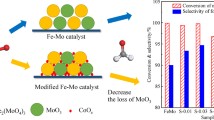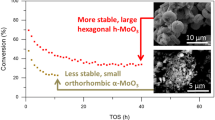Abstract
From solutions of ammonium molybdate this salt was precipitated with acetone. Decomposition in air at 330 °C yields MoO3 with a specific surface area of 17 m2/g, by means of reduction with hydrogen 4.5, 4 and 3.5 valent oxides may be formed with 30, 50 and 80 m2/g, respectively. Molybdenum (VI) oxide present as a monomolecular layer on supports is much less readily reduced than unsupported MoO3. This difference reflects the interaction of Mo ions with ions of the support. The reducibilities of the various catalysts show that Mo(VI) oxides interact far less with SiO2 than with Al2O3, CeO2 and ZrO2. This is also reflected in the rates of 2-propanol decomposition on these catalysts, the activities on MoOx and on MoOx−SiO2 being much higher than on the other catalysts.
Abstract
Соль молибдата аммония была выла высаждена из ацетона. Разложение на воздухе при 330°C приводит к образованию MoO3 с удельной поверхностью 17 м2/г; при восстановлении водородом образуются окислы с валентностью 4,5,4 и 3,5, удельная поверзность которых равна 30, 50 и 80 м2/г, соответственно. Окись молибдена (VI), присутствующая в виде мономолекулярного слоя на носителе, восстанавливается гораздо труднее, чем MoO3 без носителя. Это различие отражает взаимодействие ионов Mo с ионами носителя. Способность к восстановленю различных катализаторов указывает на то, что окислы Mo(VI) взаимодействуют гораздо слабее с SiO2, чем с Al2O3, CeO2 n ZrO2. Это отражается на скоростях разложения 2-пропанола в присутствии этих катализаторов. Активность на MoOx и на MoOx−SiO2 намного выше, чем в случае других катализаторов.
Similar content being viewed by others
References
J. von Destinon-Forstmann: Can. Metallurgical Quart.,4, 1 (1965).
D.T. Hawkins, W.L. Worrell: Metall. Trans.,1, 271 (1970).
C. Vassilev, T. Nikolov and M. Chimbulev: Trans. Inst. Mining and Metallurgy,77, C 36 (1968).
H. Kay, B.G. Langston: J. Metals, 877 (1964).
A. Cimino, B.A. De Angelis: J. Catal.,36, 11 (1975).
O. Bertrand, L.C. Dufour: Compt. Rend., C.,278, 315 (1974).
A. Sárdi: Acta Chim. (Budapest),39, 145 (1963).
F. E. Massoth: J. Catal.,30, 204 (1973).
P. Sondag, Do Quang Kim, F. Marion: Compt. Rend., C,259, 4704 (1964).
T. Fransen, O. van der Meer, P. Mars: J. Phys. Chem. (In press).
P. Bourret, J. Lecuire, C. Weis: Chim. Anal.,52, 48 (1970).
M.R. Hillis, C. Kemball, M.W. Roberts: Trans. Faraday Soc.,62, 3570 (1966).
J. Sonnemans, P. Mars: J. Catal.,31, 209 (1973).
T. Fransen, P.C. van Berge, P. Mars in: “Preparation of Catalysts”, Proc. Int. Symp., Brussels, 1975, p. 405. Elsevier, Amsterdam 1976.
P. Ratnasamy, A.V. Ramaswamy, K. Banerjee, D.K. Sharma, N. Ray: J. Catal.,38, 19 (1975).
Author information
Authors and Affiliations
Rights and permissions
About this article
Cite this article
Fransen, T., van Berge, P.C. & Mars, P. Reduced molybdenum oxide catalysts with high surface areas. Preparation and activites. React Kinet Catal Lett 5, 445–452 (1976). https://doi.org/10.1007/BF02060893
Received:
Accepted:
Issue Date:
DOI: https://doi.org/10.1007/BF02060893




